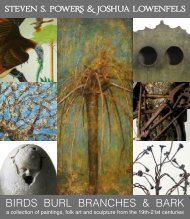INSIDER / OUTSIDER
The definition of Outsider Art is fraught with issues—as online trolls will attest—and, I will not attempt to define it here. However, to further confuse the issue, I will bring forth a few of what I would call “insider/outsider” artists such as Forrest Bess, Frank Overton Colbert, Ida Jones and John Roeder. Individuals that are hard to pigeonhole and overlap with Outsider, Folk, Self-taught, and schooled artists. Can an artist be an “outsider” if you they had some instruction, but have a minority’s perspective? Are all outsider artists self-taught? If they spent time in a mental institution are they automatically an “outsider?” Can one be an “outsider” if they were on the fringe of society, but then thrust into the New York gallery scene and continued to create art that was then for resale? As with most things, a case-by-case examination and identification of context is key to aiding any definition (if one must be so defined). In the following pages, we will present a number of artists and works of art that overlap, transition or fit by context into this insider/outsider scheme. In addition. we will have works by Dilmus Hall, George Morgan, Henry Speller, George Ohr, Eugene Andolsek, Henry Ray Clark and others. January 18-21, 2018. Metropolitan Pavilion, 125 W 18th St, New York, NY 10011
The definition of Outsider Art is fraught with issues—as online trolls will attest—and, I will not attempt to define it here. However, to further confuse the issue, I will bring forth a few of what I would call “insider/outsider” artists such as Forrest Bess, Frank Overton Colbert, Ida Jones and John Roeder. Individuals that are hard to pigeonhole and overlap with Outsider, Folk, Self-taught, and schooled artists.
Can an artist be an “outsider” if you they had some instruction, but have a minority’s perspective? Are all outsider artists self-taught? If they spent time in a mental institution are they automatically an “outsider?” Can one be an “outsider” if they were on the fringe of society, but then thrust into the New York gallery scene and continued to create art that was then for resale? As with most things, a case-by-case examination and identification of context is key to aiding any definition (if one must be so defined).
In the following pages, we will present a number of artists and works of art that overlap, transition or fit by context into this insider/outsider scheme. In addition. we will have works by Dilmus Hall, George Morgan, Henry Speller, George Ohr, Eugene Andolsek, Henry Ray Clark and others.
January 18-21, 2018.
Metropolitan Pavilion, 125 W 18th St, New York, NY 10011
You also want an ePaper? Increase the reach of your titles
YUMPU automatically turns print PDFs into web optimized ePapers that Google loves.
John Roeder (1877-1964)<br />
The Traveling Observatory<br />
Oil on canvas<br />
Circa: 1950<br />
Size: 14 5/8" (h) x 14 3/16" (w)<br />
Born in Luxembourg, Roeder moved Richmond, CA in 1909 with<br />
his wife and children. Roeder worked as a pipe fitter for many years<br />
and then as a gardener for the local High School.<br />
In his downtime, Roeder taught himself to paint and sculpt using<br />
found materials and inexpensive paints.<br />
The Traveling Observatory has all the elements of a complex<br />
Roeder; fantasy, mystery, humor and great trees. A man stands<br />
holding the reins of a horse-drawn<br />
carriage that then becomes a<br />
landscape of switchback trees and<br />
fences upon which two men with<br />
telescopes sit on a see-saw. At the<br />
top of this landscape are snowy<br />
white mountains with numerous<br />
moons or planets in the distant sky.<br />
Though the bulk of Roeder’s oeuvre<br />
are paintings, he did some foundmaterial<br />
sculpture and large-scale<br />
concrete sculpture for his home en-<br />
Photo of John Roeder by Imogen<br />
Cunningham, 1961


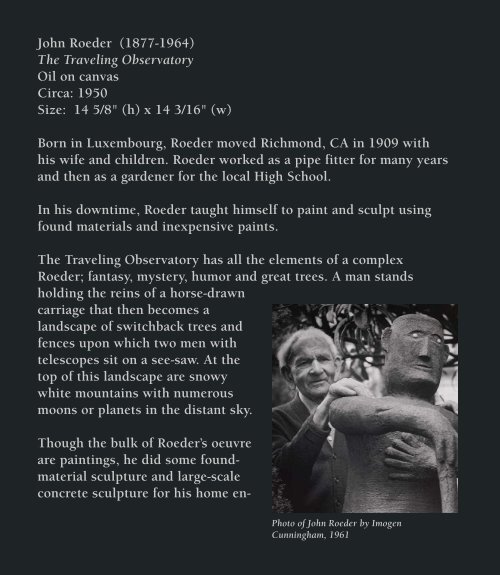

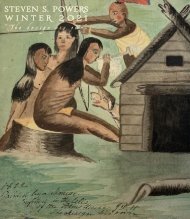
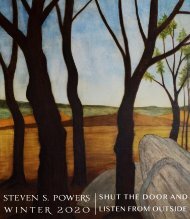
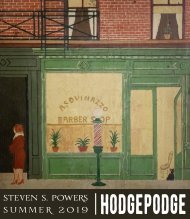
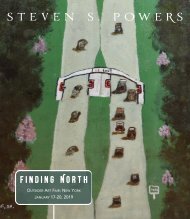
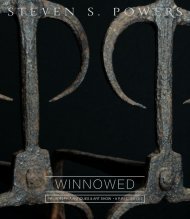
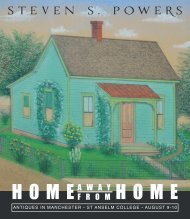
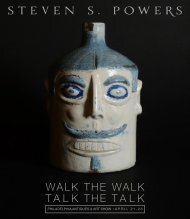
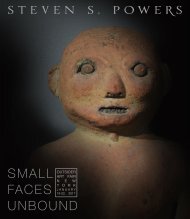

![NEEDLE • KNIFE • TORCH [&] BRUSH](https://img.yumpu.com/55309753/1/190x219/needle-o-knife-o-torch-brush.jpg?quality=85)
